| . | . | . |
| abekawa-mochi 安倍川餅 |
. | A soft rice cake coated with kinako (soybean flour) |
| Abe Shintaro 阿部晋太郎 |
. | (1924〜1991) Abe Shinzo's father. A member of the Diet that belonged the Liberal Democratic Party |
| Abe Shinzo 阿部晋三 |
. | (1954- ) a member of the Diet that belongs the Liberal Democratic Party |
| abura 油 |
. | Any kind of oil, grease or fat. abura o uru / (lit.sell oil) = (exp) to loaf (particularly on the job) |
| aburana (nanohana/nabana) アブラナ |
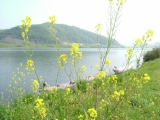 |
rape.most important stuff for the cooking oil obtained from its seeds. leaves and flowers are also eatable, a little bit bitter and tasty. |
| ACOM | . | Consumer finance company providing credit to individuals |
| aemono,和え物 -ae、−和え |
. | a kind of Japanese- style cooked salad, fish or/and vegetables with thick
dressing ( e.g. miso-ae, goma-ae ) |
| agari あがり |
. |
Freshly drawn green tea, sushi-bar term The word of "agari" has been used since the Edo period. There are several explanations regarding the origin of this word.. ex)In the Edo period, in the world of the licenced quarter, people called the last tea served to the visitors "agari". When they didn't have any customer, they grinded the tea (powder tea for tea ceremony). Grind (hiku) and 'go out' (hiku) are the same pronunciation in Japanese. So they prefer using"agari". At the sushi bar, workers use "agari", but customers don't. use. |
| age (aburage/ aburaage) アゲ |
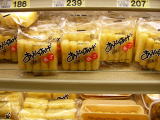 |
fried beans cured |
| age-dashi-dofu 揚げだし豆腐 |
. | oistured atsuage coated with katakuriko/wheat flour and served with shaved dried bonito and grated ginger in a soysauce-based sauce |
| age-kamaboko | . | deep-fried kamaboko |
| agemono, -age |
. | deep-fried foods (e.g.. kara-age, su-age, kakiage, tatsuta-age, ) |
| ago-wan | 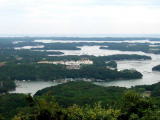 |
Ago Bay in Mie Pref. Famous with fisheries of pearls |
| agura | . | a way of sitting. sit cross-legged > seiza |
| ahiru | 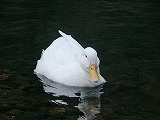 |
duck |
| ai (愛) | . | love |
| ai (藍) | . | indigo |
| aiaigasa | Share an umbrella. When a man and a woman share an umbrella, it sometimes means their good relation. |
|
| Aichi-ken (external link) |
. | Aichi Prefecture. Nagoya is in Aichi Pref. |
| aien-ka | . | habitual smoker , heavy smoker |
| aikagi | . | duplicate key |
| aikido | . | one of the traditional martial arts for self-defense |
| ai-kyogen | . | a comic interlude performed between two Noh ( tragedies ) |
| ainame | . | fat greenling . nitsuke is the best way to eat. |
| ainu | . | the Ainu race. most of them live in Hokkaido |
| aisatsumawari | . | To make around of visits to business connections or relatives or those above us at work who have been helpful or kind to when people get married or new years day, etc. |
| aji | horse mackerel, scad. Good for shioyaki, sashimi, nambabzuke and nitsuke | |
| ajinomoto | . | brand name for the chemical seasoning monosodium glutamate by Ajinomoto Co., Ltd. |
| ajisai | 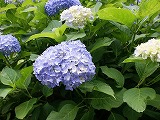 |
Hydrangea |
| ajishio | . | salt mixed with monosodium glutamate |
| ajitsuke | . | flavoring in some way, seasoning |
| ajitsuke-nori | . | seasoed laver |
| akachan |  |
baby |
| aka-chouchin | . | lit. a red Japanese lantern a big red Japanese lantern hunged at the entrance is a symbol of an inexpensive tavern. |
| akadashi | . | miso soup using akadashi miso |
| aka-gai | 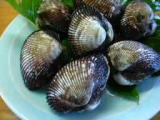 |
ark shell tasty good for sushi-neta |
| aka-jiso | - | red perilla, red labiate |
| aka-kabu | . | red turnip |
| aka-miso | . | lit. red miso. comprises about 75% of all rice miso. high in protein and salt |
| Akashi-Ohashi | 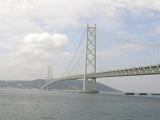 |
Akashi Bridge |
| Akaten 赤点 |
35 |
Aka 赤 means red and ten 点 means mark or grade. Failing grade When a student got a failing grade on the test, a teacher put a grade in red on a paper. |
| akatombo |  |
red dragonfly |
| akebi | . | Akebia quinata. sweet wild fruit in Autumn. lots of seeds. |
| Akibasan-Entsuji |  |
Akibasan Entsu-ji located near Atsuta Shrine (Atsuta Jingu) in Nagoya. Akiba Sanjakubo Daigongen is enshrined. The Fire Festival held on December 16th of each year is popular. |
| Akihabara | . | name of a district in Tokyo famous for the discount electronic shops. |
| aki-nasu | . | egg plant harvested in autumn |
| Aki no Miyajima |  |
It is said that Aki no Miyajima is one of the tree beautiful sceneries in Japan |
| aki-no-nanakusa |  |
the seven grasses of autumn. hagi (Japanese bush clover), obana/susuki (Japanese pampas grass), kuzu (pueraria), ominaeshi (patrinia), nadeshiko ( wild pink), fujibakama (eupatorium), kikyo (Japanese bellflower) |
| Akita-ken | . | Akita Prefecture |
| Akkanbe (Akanbe, Behda) |
 |
Childish Bronx cheer at someone. Gesture of pulling down one eyelid and sticking one's tongue out. The phrase "Akkanbe" is often accompany this gesture. |
| akushu | Shake | |
| Akutagawa-sho | . | The Akutagawa Prize. It was established to encourage new writers in the field of serious literature and is the most prestigious as far as the literary world is concerned. It is awarded twice a year along with the Naoki Prize, which is for popular literature. |
| ama (尼) | . | nun |
| ama (海女) | . | professional woman diver to catch turban shells, abalone, seaweed, pearl oyster, etc. |
| amadai | . | title fish |
| ama-ebi | . | lit. sweet prawn, pink shrimp good for sashimi or sushi |
| amagasa | umbrella | |
| ama-guri | . | lit. sweet chestnuts. small chestnuts roasted with brown sugar or syrup. Amaguri made by Imai-no-amaguri in Osu is the best in Nagoya. |
| amakudari | . | lit. descending from heaven. In common parlance it refers to the practice of tetiring public servants taking positions at private-sector enterprises and public corporations that have close relations with the agency in which the government officials were employed. |
| amami | . | sweetness |
| amanatsu | . | a kind of Chinese citron. sweetened by breeding |
| amanogawa | Milkyway | |
| amazake | lit.sweet sake. a sweet beverage made from rice and rice koji. | |
| ame (飴) | . | candy |
| ame (雨) | . | rain |
| American (coffee) | In a coffee shop "American" means "weak coffee". | |
| ami (網) | . | net |
| ami (醤蝦) | . | opossum shrimp. ver small shrimp less than 2cm at the most. |
| amidana | 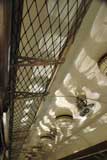 |
net rack overhead rack |
| amimono | . | knitting |
| . | . | |
| amiyaki | . | grilling done on a griddle |
| ampan | . | sweet bean paste inside a roll or bun |
| an | . | sweet bean paste |
| anago | 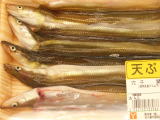 |
conger eel |
| ankake | . | some dish sauced made by mixing kuzuko or potato starch with water or stock and soy sauce etc. and heating until it becomes thick. |
| ankake-udon | noodles with thicken soup. ( => ankake) | |
| anko | angler fish | |
| ankoh-nabe | . | nabe-mono of simmered angler fish |
| anmitsu | . | mitsumame with an (sweet bean paste) |
| anoyo | . | the world after death |
| anzu | apricot | |
| Aoi-matsuri | 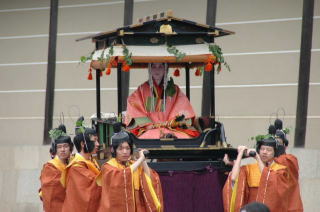 |
one of the three big festivals in Kyoto. May 15th. |
| aojiso | . | green labiate |
| Aonami Line | . | . |
| aonori | . | (ao means green and nori means laver) green laver finely crumbled powder-like. It is often used for topping okonomiyaki. |
| aotagai | . | lit. to buy futures on unharvested rice. To notify students, who organizations want to hire well, that they have decided to employ by firms before the date, which was decided by an employment agreement among firms, to keep good students. |
| aotagari | . | one of the military stratages to cut green rice in order to make enemies want of food |
| aokake-fumi | . | a traditional health maintenance device made of bamboo, which has been slit in half lengthwise. tread on it barefoot and stimulates the key pressure points of arches. |
| Aomori-ken | . | Aomori prefecture. |
| Aqua Totto Gifu |  |
- |
| ara-saa(アラサー) ara-four(アラフォー) ara-fee(アラフィー) ara-kan(アラカン) |
- | Buzzwords. "Ara" means "around". "saa" is thirty, "four" is fourty, "fee" is fifty and "kan" is kanreki 還暦 (sixty years old) |
| aradaki | . | a simmering of large fish like bream or yellowtail. The head and the body still with its bones are simmered in stock flavored with soy sauce, sake, sugar, and mirin (sweet sake) |
| arai | . | a style of sashimi for muddy taste fish like carp. Put thin sliced fish in warm water, the put it into very cold water. |
| Araizeki | - | |
| arame | . | a kind of seaweed |
| aranami | 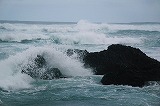 |
wild waves troubled waters rough sea |
| arare (霰) | . | little rice crackers |
| arare(霰) | . | hailstones |
| asagao | morning glory | |
| asagao-ichi | . | At Iriya Kishibojin shrine in Tokyo, there's a three-day ( July 6th-9th every year) morning glory fair called "asagao-ichi" where the potted ones are sold at stalles in the shrine area. This festival startes in the Edo period.TEL:03-3841-2569 |
| asahi |  |
morning sun, rising sun |
asa-ichi (朝一) |
asaichi means "asa ichiban ", a task what you have to do the first in the morning. There is a very interesting report. about a sense of time. According to the article of Yomiuri Newspaperon May 30th, 2006, The time of "asa-ichi" is 7:54a.m. for the average of businessmen. How about you ? |
|
| asaichi(朝市) | morning market | |
| asagutsu | 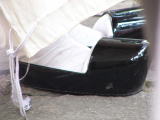 |
Laquered wooden clogs worn by Shinto priests during the rituals which held
outside. |
| asakusa-nori | . | purple laver |
| asanomi | . | Indian -hemp seeds |
| asari | . | short-neck clam |
| asari-jiru | 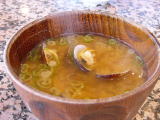 |
miso soup with short-neck clam |
| asatsuki | . | chives, a kind of green onion. very green and thin. often used as a garnish |
| ashiato | Footmark | |
| ashibi | Japanese pieris | |
| Ashitaba | . | udon franchise restaurant. One is in Motoyama. reasonable and tasty. |
| Asuke | 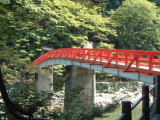 |
Asuke is one of the popular places near Nagoya. |
| atsuage | . | deep fried thick-sliced tofu |
| Atsuta Matsuri | Atsuta Festival | |
| Atsuta Jingu | 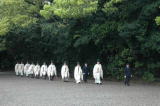 |
One of the most important shrines in Japan in Nagoya.. |
| awa | . | foxtail millet |
| awabi | abalone | |
| awa-odori | 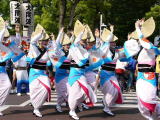 |
Awa Dance. One of the most famous Bon Dances in Japan. It is held for four days from August 12. |
| awase-miso | 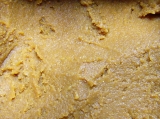 |
a sort of miso |
| ayatori | . | cat's cradle |
| ayu | . | sweetfish |
| ayu no shioyaki | 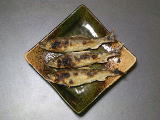 |
broiled ayu with salt most popular way of cooking ayu |
| azuki | . | azuki bean. used for sekihan, zenzai, Japanese sweats, etc. |
Kikuko's Picture Dictionary